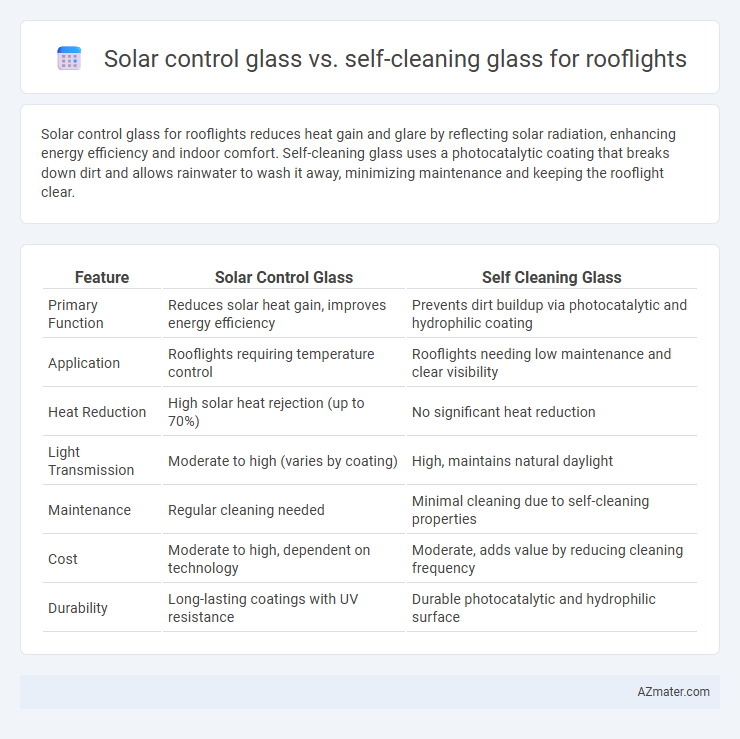Solar control glass for rooflights reduces heat gain and glare by reflecting solar radiation, enhancing energy efficiency and indoor comfort. Self-cleaning glass uses a photocatalytic coating that breaks down dirt and allows rainwater to wash it away, minimizing maintenance and keeping the rooflight clear.
Table of Comparison
| Feature | Solar Control Glass | Self Cleaning Glass |
|---|---|---|
| Primary Function | Reduces solar heat gain, improves energy efficiency | Prevents dirt buildup via photocatalytic and hydrophilic coating |
| Application | Rooflights requiring temperature control | Rooflights needing low maintenance and clear visibility |
| Heat Reduction | High solar heat rejection (up to 70%) | No significant heat reduction |
| Light Transmission | Moderate to high (varies by coating) | High, maintains natural daylight |
| Maintenance | Regular cleaning needed | Minimal cleaning due to self-cleaning properties |
| Cost | Moderate to high, dependent on technology | Moderate, adds value by reducing cleaning frequency |
| Durability | Long-lasting coatings with UV resistance | Durable photocatalytic and hydrophilic surface |
Understanding Solar Control Glass
Solar control glass for rooflights significantly reduces solar heat gain by filtering infrared and ultraviolet rays, enhancing indoor comfort and energy efficiency. This type of glass typically incorporates low-emissivity coatings and tinted layers that reflect unwanted solar radiation while allowing natural light to pass through. Unlike self-cleaning glass, which uses a photocatalytic coating to break down dirt and rain to wash it away, solar control glass primarily focuses on thermal regulation rather than surface maintenance.
What Is Self-Cleaning Glass?
Self-cleaning glass for rooflights features a special photocatalytic coating that breaks down organic dirt when exposed to sunlight, allowing rainwater to wash it away, reducing maintenance needs. This innovative glass enhances natural light while maintaining clarity, unlike solar control glass which primarily focuses on reducing heat gain and glare by reflecting infrared radiation. Choosing self-cleaning glass improves rooflight longevity and energy efficiency by minimizing cleaning efforts and maximizing daylight transmission.
Key Differences Between Solar Control and Self-Cleaning Glass
Solar control glass for rooflights primarily reduces heat gain and glare by reflecting and absorbing solar radiation, enhancing energy efficiency and indoor comfort. Self-cleaning glass features a special coating that breaks down organic dirt and allows rainwater to wash it away, minimizing maintenance and keeping the glass clear. The key difference lies in functionality: solar control glass optimizes thermal regulation, while self-cleaning glass focuses on reducing cleaning frequency and improving visibility.
Energy Efficiency: Which Glass Performs Better?
Solar control glass outperforms self-cleaning glass in energy efficiency for rooflights by significantly reducing solar heat gain, lowering cooling costs during summer. Self-cleaning glass primarily offers maintenance benefits by breaking down organic dirt with UV light but lacks substantial thermal insulation properties. Choosing solar control glass enhances energy savings through improved thermal regulation and glare reduction.
Maintenance Requirements: Cleaning and Upkeep Compared
Solar control glass for rooflights reduces heat gain and UV damage, minimizing the frequency of cleaning needed by preventing dirt buildup caused by excessive heat-related debris. Self-cleaning glass incorporates a special photocatalytic coating that breaks down organic dirt and uses rainwater to wash surfaces, significantly lowering manual cleaning efforts. Both options enhance maintenance efficiency, but self-cleaning glass offers superior advantages in reducing routine upkeep and maintaining clarity with minimal intervention.
Light Transmission and Glare Reduction
Solar control glass for rooflights offers superior glare reduction by filtering out harmful UV and infrared rays while maintaining moderate light transmission levels, typically ranging from 40% to 60%. Self-cleaning glass emphasizes high light transmission, often exceeding 70%, by using a photocatalytic coating that breaks down organic dirt and allows rainwater to wash it away, but it provides only minimal glare reduction. Choosing between the two depends on balancing the need for glare control and maximizing natural daylight within the space.
Aesthetic Impact on Rooflight Design
Solar control glass enhances rooflight design by reducing glare and heat while maintaining clear visibility, offering a sleek, tinted appearance that complements modern architecture. Self-cleaning glass preserves the aesthetic appeal by minimizing dirt and water spots, ensuring the rooflight remains visually clear and bright with reduced maintenance. Combining these technologies can balance functional efficiency with a clean, attractive rooflight design that boosts natural light and energy performance.
Cost Comparison: Initial Investment and Long-Term Value
Solar control glass for rooflights typically has a higher initial investment due to advanced coatings that reduce heat gain and improve energy efficiency. Self-cleaning glass may have a moderate upfront cost but offers long-term savings by reducing maintenance and cleaning expenses. Evaluating total lifecycle costs reveals solar control glass adds value through energy savings, whereas self-cleaning glass provides cost efficiency in upkeep.
Durability and Lifespan Considerations
Solar control glass for rooflights offers enhanced durability with coatings designed to withstand harsh weather and UV exposure, typically lasting 15-20 years without performance degradation. Self-cleaning glass incorporates a durable photocatalytic and hydrophilic coating that resists dirt accumulation and maintains clarity for approximately 10-15 years under normal environmental conditions. When choosing between the two, solar control glass generally provides a longer lifespan and superior resistance to environmental wear, while self-cleaning glass reduces maintenance efforts but may require more frequent replacement in harsh climates.
Choosing the Right Glass for Your Rooflight
Solar control glass for rooflights effectively reduces heat gain and glare by reflecting infrared and ultraviolet rays, enhancing energy efficiency and indoor comfort. Self-cleaning glass features a photocatalytic coating that breaks down organic dirt and a hydrophilic surface that helps rainwater wash away residues, minimizing maintenance efforts. Choosing between these options depends on whether prioritizing thermal performance or ease of cleaning best suits your building's environmental conditions and maintenance capabilities.

Infographic: Solar control glass vs Self cleaning glass for Rooflight
 azmater.com
azmater.com